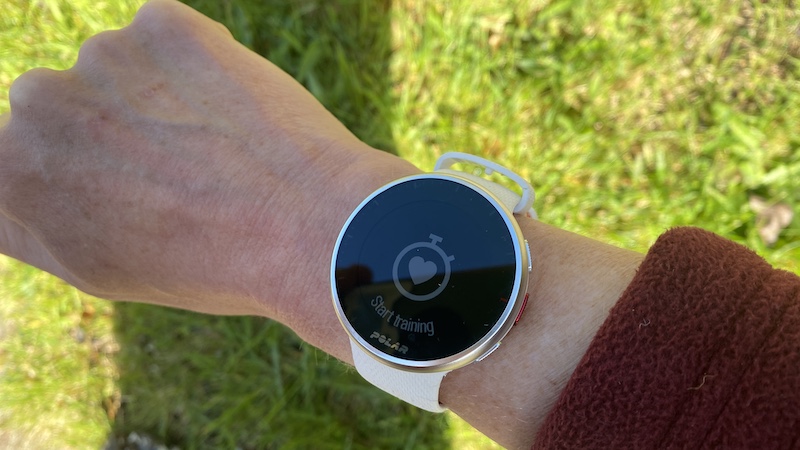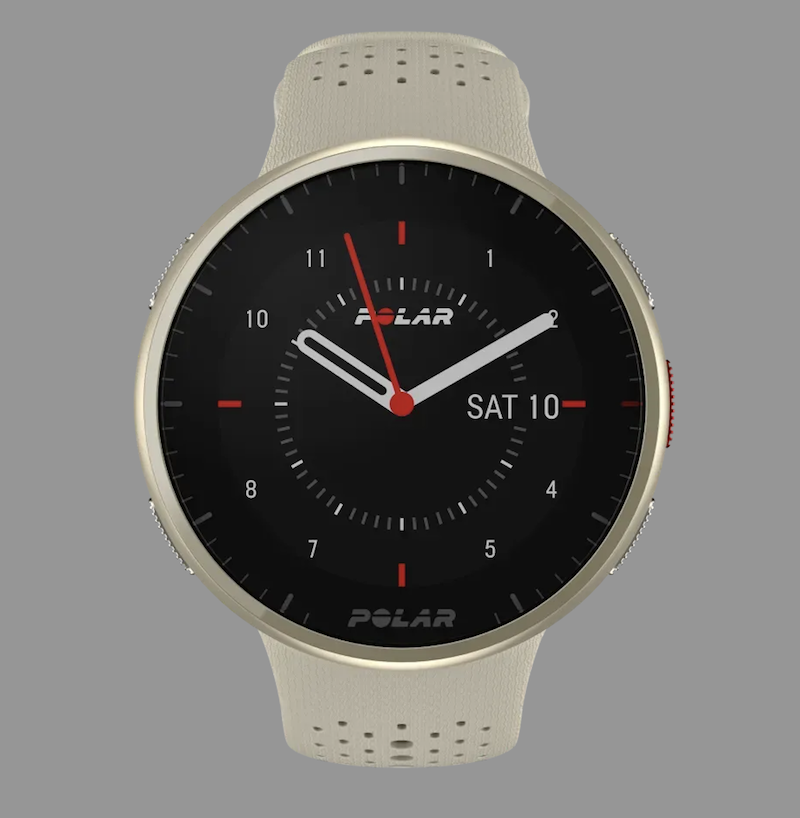I have been testing the Polar Pacer Pro GPS sports watch. Polar state: “This is an ultra-light, new-generation sports watch with integrated barometer that equips athletes with advanced tools to improve running economy, training sessions and sports performance.” Read on to find out my thoughts.
Features of the Polar Pacer Pro GPS watch
There are numerous features so I’m listing some of the ones that I think are most important.
- Dimensions: 45mm x 45mm x 11.5mm
- Weight: Without strap 23g; with strap 41g
- Display type: MIP – Memory in Pixel (low power consumption, high contrast and screen brightness)
- Display size: 30.48mm (1.2in)
- Display resolution: 240 × 240
- Storage: 32 MB
- Case material: Plastic
- Screen material: Gorilla Glass
- Bezel material: Aerospace aluminium
- GPS, Glonass, Galileo, QZSS
- Connectivity: Bluetooth
- Water resistance: 50m
- Barometer
- Compass
- Accelerometer
- Five colour choices
- Removable watch strap
Battery:
- Battery life training mode, up to: 35 hours
- Battery life watch mode, up to 144 hours
- Battery life with power save training mode, up to 100 hours.
- Price: £231 to £289 depending on colour
- See: Polar, as well as Amazon (I receive a small commission for sales via Amazon)
My thoughts: Polar Pacer Pro GPS watch
Polar has taken many features from their higher spec GPS watches and designed them into the Polar Pacer Pro, but at a cheaper price. The watch is more focused on running. (Note, there is a Polar pacer version and that has fewer features.)
There are other some other modes, such as cycling, strength training, HIIT, walking and triathlon, which are pretty much all I need. Sometimes I use a kayaking mode or a ski mode but some watches have so many modes it seems a bit over the top. For example, a very niche mode of “mermaiding” on the Suunto 9 Peak Pro.
I understand that brands want to compete on features but I’d rather they focused on creating a GPS watch that is great for one of two sports and kept the price down. This is what Polar appears to be aiming to achieve with the Polar Pacer and the Polar Pacer Pro.
There are some differences when you compare the higher spec – and more expensive –– Polar watches. The Polar Pacer Pro doesn’t have a touchscreen and it has a slightly smaller watch face size. The Polar Pacer Pro is also made of plastic, rather than a lightweight metal. I don’t think these are major issues.
There are some positives of the cheaper Polar Pacer Pro, such as a nice and bright display, even when when it’s light and sunny outdoors. You can choose from a range of different watch faces (these are found in the setting section of the watch).
One area that you should note is battery life. There needs to be some sacrifices for the price of this watch and this is where Polar has most likely made some savings. The battery does last for last days but not weeks as with other higher spec sports watches, such as the Garmin Enduro.
In normal watch mode, while doing some outdoor activities, the the Polar Pacer Pro should last up to about six days. I got about four to five days but it does depend on what I did each day.
In training mode, making more use of the GPS for tracking etc, Polar reckon it’s about 35 hours of battery. There are some power saving training modes you can use to make the battery last a bit longer.
Compare this to pricier watches such as Garmin Enduro, Suunto 9 Peak Pro and Coros Apex 2 Pro and you’ll see there is a more limited battery life. Saying that, many people want a watch that they can use for a big day out, or a couple of days, and they are happy to recharge with a powerbank or back at home.
It’s a bit of a price versus battery life thing with sports watches these days I think.
A great feature is the barometric altimeter, which accurately tracks elevation. This is an excellent feature for a lower priced watch. In addition, there is a hill splitter mode that collects data in real-time so you can see your pace on ascents and descents. This is good for keeping track of hill reps and intervals as you do them. (Note, the more basic Polar Pacer doesn’t have the barometer.)
The heart rate monitor is on the wrist. This is rarely as accurate as a chest heart rate monitor but they are becoming more and more accurate. If the watch doesn’t fit neatly to the wrist or you get bumps and jiggles when doing exercise, you might find the watch loses pulse tracking, but, overall, when tracking like for like for me, I found it as good as other more expensive watches.
The watch has a mode to track walking Vo2 Max, as well as running Vo2 max. To do this you need to go into the “tests” area of the watch. I am never that convinced about the accuracy of Vo2 max data but it’s useful to compare week to week for personal info.
Navigation on the Polar Pacer Pro is by breadcrumb tracking rather than with a full-on map. If you have uploaded routes, such as from Komoot GPX files, you will get turn-by-turn prompts and if you go off track the watch will tell you the direction to go in to re-find your route. (Note, this watch will not show you the details of tracking back to your route.)
I found GPS tracking and accuracy to be great. It compared well with other more expensive sports watches that I own/ have tested and also with friends’ GPS watches who were out with me.
One thing that irritated me a bit, however, was that the stop button for activities is different from the start button. If you press the start button after starting an activity, it pauses the activity. To end the activity you have to press another button. This is different from my other sports watches and it left me flummoxed until I checked the on-line manual. I guess you will get used to the buttons if it is your main watch but this seems a bit of an oddity to me.
There are bluetooth tethering options for devices such as cadence pods, chest heart rate monitor strap etc. Note, these are not Ant+ compatible.
Like many modern sports watches there are some further useful features including weather forecasts, music controls and one-way message notifications, such as texts (you can view them but not reply).

Polar offers plenty of training data. The Polar Flow app has some more limited data info, while the desktop version has a lot more data and stats to assess.
You can also utilise a FitSpark feature for fitness training information. This is based on your fitness level, activity history and recovery data. This is actually pretty good and there are prompts if you want them. The prompts give tips for exercises and training you can do to improve your fitness.
There is a Nightly Recharge recovery measurement, as well as a sleep tracking mode, which can both be very useful. Many sports watches offer lifestyle info, such as steps walked, sleep patterns etc and Polar has plenty of data for you to look at. The Nightly Recharge shows you how well your body has coped with the overall stress of recent activities and reveals data such as HRV, REM and breathing rates.
Another feature is called FuelWise, which allows you to set your “fuelling” requirements to remind you to keep eating/hydrating through activities.
There are also in-watch timers, a “serene” mode with breathing exercises and Strava live segments.
The watch syncs with an app that provides all the usual data you would expect. You can see at a glance daily, weekly and monthly info for stats such as steps, distance, active time, calories used and “useful” sleep.
Conclusion: Overall, for the money, this is a great sports watch and especially for runners. It also looks smart.






